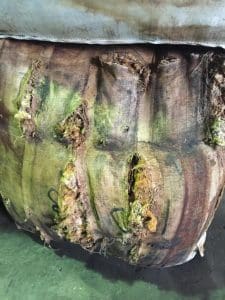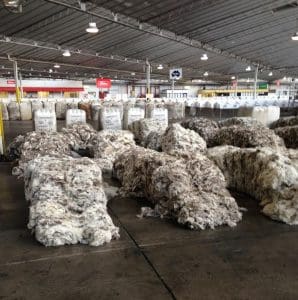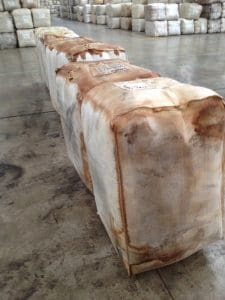
A severely water-damaged wool bale.
SHEEP producers nationally have welcomed recent sustained rainfall, but the return of widespread wet weather has brought its own set of issues for some wool growers and brokers.
Wet wool might seem a logical outcome of the good rainfall as growers struggle to get sheep shorn dry for shearing and bales out of moisture’s way, but brokers report most wool growers and carriers have managed to keep the clip dry despite ongoing rain.
However, some wool clips arriving wet in wool stores have prompted reminders to ensure adequate tarping during storage on farms and during transport, and to review whether in transit insurance covers weather damage.
The problem has been experienced by brokers nationally, with several incidents in Adelaide. In one example, some wet bales were missed and not picked up during testing in the store before sale. The damage was identified at the dumping stage, when bales are pressed together for shipment. The bottom 70 kg of affected bales was water-damaged.
During the recent inaugural AWEX Wool Pipeline Tour in Melbourne, classers were told wet bales had been an issue for brokers and for wool test coring at the Brooklyn stores and selling centre. Use of stained secondhand bales could also disguise water damage.
Elders manager wool selling centres Simon Hogan said he had heard of one instance with another broker where wool was shorn this year that was too wet to be pressed. A wool classer recently enquired about baling wet bibs and oddments. Mr Hogan said any wet wool put in butts during shearing needs to be spread out and dried before pressing.
“Because once it is pressed and it heats, it will damage the fibre and if the wool has to be spread out down here that is additional cost, so you are better off to be safe and ensure wool is dry.”
Uncovered or poorly tarped wool bales are an issue
Mr Hogan said brokers were frustrated when they had to receive inadequately tarped wool.
“There is a perception from some growers that the wool packs are a good enough tarp, but I think the new nylon pack absorbs moisture a lot more than the old poly packs.
“Unfortunately we’ve had a number of cases this year where we’ve had to dry wool.
“It is a long time since we’ve had a wet winter and load really have to tarped properly.”
Problems have been experienced at wool receivals at Dubbo, Lara and Brooklyn.
“It’s not one state, it has been everywhere, although the percentages have been small, but it is a frustration.”

Wet wool drying in the Brooklyn wool store.
Wet bales can sometimes be dried out with the help of sun and wind, but in a number of cases bales had to be tipped and spread, he said.
“From about July onwards we’ve had odd instances and we’ve sent emails out to our network alerting them to the issue and to pass it onto growers.
“We’ve had some unfortunate situations where wool has been inadequately tarped, weather has come in and bales have sat in water for a week or so.
“The bit that worries us is neglect and if it is rainy weather and somebody doesn’t tarp a load it is frustrating.”
Mr Hogan said bales of wool can’t be cored and tested if they are wet, which can hold up its eventual sale.
“Depending on the weather and whether you can get bales out to dry, it is an inefficient costly process to dry wool in store.
“We err on the side of the caution, because the last thing we want is a claim in China,” he said.
“It just makes sense to fix the problem here and be 100 percent sure the problem is fixed before we offer wool for sale and export.”
Weather-delayed shearing is biggest concern
Landmark’s south-east wool manager Stephen Keys said the company had not received any wool that had been shorn wet.
“We don’t get very many of them, but there is certainly been an odd case where wool has been wet on the truck – whether that is sitting on a carrier’s truck or woolgrowers have stored it on a trailer.
“But obviously it is just critical to have it tarped wherever it is in storage or in transit by a transport company,” he said.
“It is critical for it to be tarped and covered up, certainly with the weather we have had recently.”
“It can happen at any time – we haven’t actually seen an increase in cases over the last few months; it’s only very occasionally – the last one could have been 3-4 months ago.”
Mr Keys said most carriers and growers are very “switched on and do a great job”.
“But occasionally there is just the odd one that slips through – it hasn’t been a big issue and even with the rain you might think you would see more, but we certainly haven’t seen it coming into the Brooklyn store.”
But Mr Keys said a lot of shearing was being held up because of the wet weather.
“That’s probably our biggest issue at the moment and when the wool comes in it might have 13 months growth on it or more in some cases.
“That could put some pressure on those longer types,” he said.
“It still wouldn’t be classed as over-long, those wools between 110-120 millimetres, which are OK if they are sound, but if they are tender with a high mid-break they are certainly coming under some pressure.”
Mr Keys there is a big increase in growers wanting to shear at 6-10 months of growth.
“Those that have tried it, most of the results are pretty encouraging.”
Growers dealing mostly with ‘wet edges’
Rodwells wool manager Michael de Kleuver said keeping wool dry enough to shear has been challenging for clients and some growers have had to contend with “wet edges” – skirtings and bellies.
“We haven’t seen too many hassles so far.
“It has not been too bad, but if they press things wet that’s when the trouble starts,” he said.
He believed many of the sheep shorn in the last six weeks probably would not have been shorn in a dry year.
“But in a year like this, everybody is trying to get it done and time is getting away a little bit – so people are probably shearing sheep that are a bit damper — probably around the edges – than they normally would be.”
Mr de Kleuver said provided wool is processed reasonably quickly the impact of moisture is diminished.
“It’s when it sits around wet for a long time; lying in water is probably a bigger issue than damp wool when it is shorn.
“So far, not so bad.”
Issues with wet wool would vary depending on where wool was drawn from, he said.
AWEX advises wet wool must not be pressed

Wet wool bales in the Brooklyn wool store.
AWEX wool classer registrar Fiona Raleigh said she understood the pastoral award specified an employee may refuse to shear sheep without any responsibility for any delay if the overseer or the shed representative agree that the sheep are too wet.
“So that is the case if the wool classer has been assigned the job of the shed representative, which isn’t always the case.
“I don’t think you can make a blanket statement that the wool classer has that authority – it’s the shed representative.”
Shearers often vote on whether or not to shear sheep considered wet, but according to the award, individual employees can also make their own decision to shear or not if the vote’s majority result is that the sheep are dry.
“So everyone has the right to refuse on a dry vote.”
But Ms Raleigh said AWEX advised that wet wool must not be pressed in bales.
“And David Cother (AWEX wool services manager) said that whenever we use the word ‘must’ in the Preparation of Australian Wool Clips Code of Practice it means exactly that – it must not be pressed.
“But we understand a wool classer may be required to press — we want people to stay employed.”
Ms Raleigh said if wool classers are required to press wool they consider to damp or wet in a cut-out, they should write down the affected lines on the wool specification, and contact her and the wool-selling agent.
“We want those bales identified if they can’t be dried out in shed.”
There have been more queries to AWEX about wet wool from classers in recent months, she said.



Can wet wool create spontaneous combustion Fiona? I have handled butts of wet stained crutchings that were very hot and steaming. I told the manager to spread them out on the wool floor to dry.